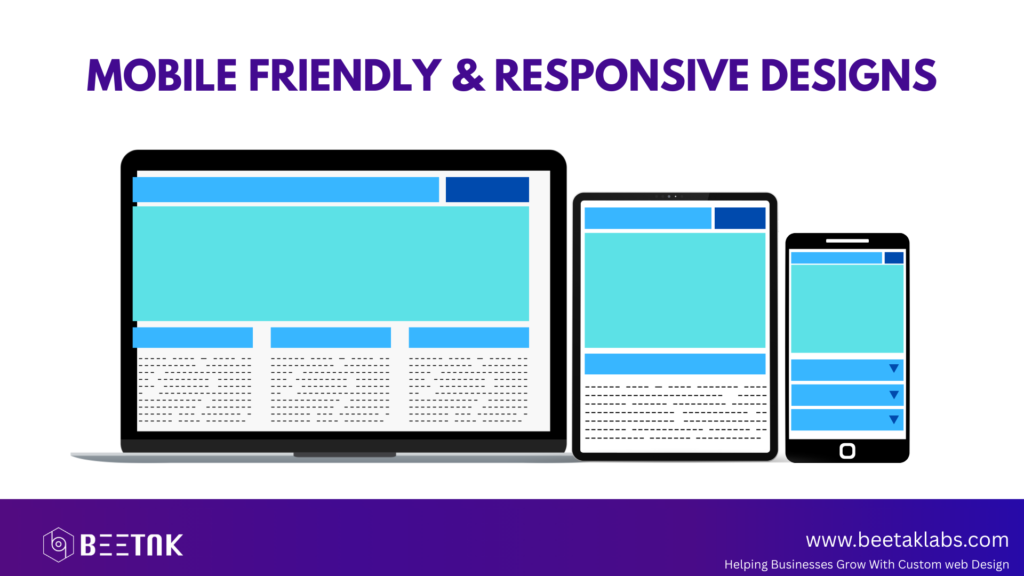Introduction
A business website is more than just an online presence—it’s a powerful tool that drives engagement, generates leads, and boosts sales. In today’s digital world, a poorly optimized website can cause businesses to lose potential customers. To stand out and stay competitive, a website must be fast, secure, user-friendly, and optimized for search engines.
Here are the 10 essential features that every high-performing business website needs to maximize visibility, user experience, and conversions.
1. Mobile-Friendly & Responsive Design
With over 60% of web traffic coming from mobile devices, a website must be fully responsive to provide a seamless experience across smartphones, tablets, and desktops. A mobile-friendly website:
- Automatically adjusts to different screen sizes
- Improves user experience (UX) and engagement
- Reduces bounce rates
- Enhances SEO rankings
Google prioritizes mobile-first indexing, meaning websites that are not mobile-friendly will struggle to rank in search results. To check if your website is mobile-friendly, use Google’s Mobile-Friendly Test.

2. Fast Loading Speed for Better Performance
Website speed is crucial for both user experience and search engine rankings. Studies show that 53% of users abandon a website if it takes longer than three seconds to load.
To ensure lightning-fast load times, websites should:
- Compress images and optimize file sizes
- Enable browser caching and Content Delivery Networks (CDN)
- Minimize JavaScript, CSS, and HTTP requests
- Choose high-performance web hosting
Choose high-performance web hosting
Fast websites reduce bounce rates, improve engagement, and boost conversions. Google also uses page speed as a ranking factor, making performance optimization critical for SEO success. Test your website speed and get optimization recommendations using Google PageSpeed Insights.
3. SEO Optimization for Higher Search Visibility
A website must be search engine optimized (SEO) to attract organic traffic and rank higher in Google search results. A well-optimized site should include:
- Keyword-rich content with natural placement
- SEO-friendly URLs (e.g., www.example.com/services)
- Proper meta tags, title tags, and alt text for images
- Internal linking to improve site structure and navigation
Technical SEO factors such as site speed, mobile-friendliness, and structured data also play a crucial role in increasing visibility. Websites that follow SEO best practices are more likely to reach target audiences and drive sustainable traffic. For a detailed guide on SEO best practices, refer to Google’s SEO Starter Guide.
4. Secure HTTPS & SSL Certification
Website security is essential for protecting user data and building trust. An SSL certificate (HTTPS encryption) safeguards sensitive information and prevents cyber threats.
Why HTTPS is essential:
- Encrypts data between users and the server
- Enhances trust and credibility
- Helps with SEO rankings (Google favors secure websites)
- Prevents data breaches and cyberattacks
Search engines mark non-HTTPS websites as “Not Secure,” discouraging visitors. A high-performing business website must have strong security measures in place to protect both the business and its users.
5. Intuitive Navigation & User Experience (UX) Design
A seamless navigation system ensures that users find the information they need quickly. Poor navigation frustrates visitors, leading to higher bounce rates and lost conversions.
Key elements of effective website navigation:
- A simple and structured menu layout
- Clear page hierarchy with easy-to-follow categories
- A search bar for instant content discovery
- Logical internal linking to keep users engaged
A well-structured website improves user satisfaction, engagement, and conversion rates, ensuring visitors stay longer and explore more pages.
6. High-Quality Content & Engaging Visuals
Content plays a major role in attracting, engaging, and converting visitors. A business website should provide valuable, well-structured, and SEO-optimized content that resonates with the audience.
Key content elements include:
- Clear and compelling headlines that capture attention
- Informative blog posts, product descriptions, and service pages
- Engaging visuals, infographics, and videos
- Clear and persuasive messaging that aligns with brand identity
Well-crafted content helps establish credibility, boost SEO rankings, and drive user engagement.
7. Strong Call-to-Action (CTA) Elements
A high-performing website should guide visitors toward taking action through strategically placed Call-to-Action (CTA) buttons.
Examples of effective CTAs:
- “Get Started Today”
- “Download Your Free Guide”
- “Sign Up for Exclusive Updates”

CTAs should be visually appealing, action-oriented, and easy to find to increase conversions. Websites without strong CTAs miss opportunities to convert visitors into customers.
8. Contact Information & Live Chat Support
A business website must provide clear and accessible contact information to build trust and improve user experience. The easier it is for customers to reach out, the higher the chances of engagement.
Key elements of an effective contact section:
- Visible email and phone number
- Easy-to-use contact forms
- Live chat or AI-powered chatbots for real-time support
Live chat features enhance customer service, boost engagement, and increase sales conversions.

9. Social Media Integration for Brand Growth
Social media plays a critical role in expanding brand reach and engagement. A website should be seamlessly connected to social platforms to encourage sharing and interaction.
Key benefits of social media integration:
- Increases brand awareness and credibility
- Drives traffic from social networks
- Encourages user-generated content and community engagement
Adding social sharing buttons, embedded feeds, and follow links makes it easier for users to connect with the brand across multiple digital channels.
10. Analytics & Performance Tracking for Optimization
To improve performance, businesses must track user behavior and website metrics. Integrating tools like Google Analytics provides valuable insights into:
- Visitor demographics and traffic sources
- Page views, bounce rates, and session duration
- Conversion tracking and user behavior flow
Analyzing real-time website data allows businesses to refine marketing strategies, optimize content, and enhance overall website performance.



